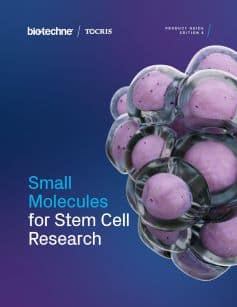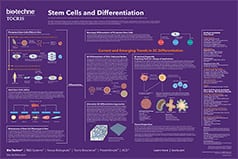Hedgehog Signaling
The Hedgehog (Hh) signaling pathway is crucial in the development of all animals. In the embryo, it regulates morphogenesis of a variety of tissues and organs; in the adult, it controls stem cell proliferation. There are three known human Hh proteins: Shh, Dhh and Ihh.
Hedgehog Signaling Inhibitors |
|
|---|---|
| Cat. No. | Product Name / Activity |
| 1639 | AY 9944 dihydrochloride |
| Inhibitor of Hedgehog (Hh) signaling. Inhibits Δ7-dehydrocholesterol reductase | |
| 4529 | Ciliobrevin A |
| Hedgehog (Hh) pathway antagonist, inhibits ciliogenesis; also inhibits dynein | |
| 1623 | Cyclopamine |
| Inhibitor of Hedgehog (Hh) signaling | |
| 6896 | Dynapyrazole A |
| Hedgehog signaling inhibitor; dynein inhibitor | |
| 6526 | Dynarrestin |
| Inhibitor of Hedgehog (Hh) signaling; inhibits cytoplasmic dynein | |
| 3191 | GANT 61 |
| GLI antagonist; inhibits Hedgehog (Hh) signaling | |
| 7828 | HHP 9 |
| Potent Hh pathway inhibitor; BET bromodomain Degrader | |
| 5554 | IHR 1 |
| Potent Smo antagonist | |
| 6538 | PF 04449913 maleate |
| Potent Smo antagonist | |
| 5262 | PF 5274857 hydrochloride |
| High affinity and selective Smoothened (Smo) receptor antagonist | |
| 1974 | SANT-1 |
| Inhibitor of hedgehog (Hh) signaling; antagonizes smoothened activity | |
| 7710 | Vismodegib |
| Potent hedgehog pathway inhibitor | |
Hedgehog Signaling Activators |
|
| Cat. No. | Product Name / Activity |
| 7807 | Hh-Ag1.5 |
| High affinity and potent Smo receptor agonist | |
| 4474 | 20(S)-Hydroxycholesterol |
| Allosteric activator of Hedgehog (Hh) signaling; induces Smo accumulation | |
| 4366 | SAG |
| Activates the Hedgehog signaling pathway; potent Smoothened receptor agonist | |
| 5282 | SAG 21k |
| Hedgehog signaling activator; brain penetrant and orally bioavailable | |
The Hedgehog (Hh) signaling pathway is crucial in the development of all known animals. In the embryo, it regulates morphogenesis of a variety of tissues and organs; in the adult, it controls stem cell proliferation.
There are three human Hh proteins: Sonic hedgehog (Shh), Desert hedgehog (Dhh) and Indian hedgehog (Ihh). Each is expressed at different times of development and in specific cell types and they are tightly controlled by highly complex, yet divergent transcriptional enhancers. Hh protein release and diffusion is controlled by various proteins including Skinny hedgehog (Sit), Dispatched (Disp), Tout-velu (Ttv) and Hedgehog-interacting protein (Hip). Hh proteins bind to the twelve transmembrane domain protein, Patched (Ptc). In the absence of Hh proteins, Ptc catalytically inhibits Smo. Hh-Ptc binding results in loss of Ptc activity and activation of Smo, which transduces the Hh signal to the cytoplasm. This leads to the activation of the Ci/Gli family of transcription factors, through complex interactions of Costal2 (Cos2), Fused (Fu) and Suppressor of fu [Su(fu)]. Furthermore, PKA, CK1, GSK-3 and Slimb modulate this signal transduction pathway.
Aberrant activation of the Hh pathway has been linked to multiple types of human cancer, particularly basal cell carcinoma. Disruption of Hh signaling during embryonic development, either through congenital mutation or maternal teratogen consumption, can lead to severe developmental disorders such as holoprosencephaly.
Literature for Hedgehog Signaling
Tocris offers the following scientific literature for Hedgehog Signaling to showcase our products. We invite you to request* your copy today!
*Please note that Tocris will only send literature to established scientific business / institute addresses.
Stem Cells Scientific Review
Written by Kirsty E. Clarke, Victoria B. Christie, Andy Whiting and Stefan A. Przyborski, this review provides an overview of the use of small molecules in the control of stem cell growth and differentiation. Key signaling pathways are highlighted, and the regulation of ES cell self-renewal and somatic cell reprogramming is discussed. Compounds available from Tocris are listed.
Stem Cell Workflow Poster
Stem cells have potential as a source of cells and tissues for research and treatment of disease. This poster summarizes some key protocols demonstrating the use of small molecules across the stem cell workflow, from reprogramming, through self-renewal, storage and differentiation to verification. Advantages of using small molecules are also highlighted.
Hedgehog Signaling Gene Data
| Gene | Species | Gene Symbol | Gene Accession No. | Protein Accession No. |
|---|---|---|---|---|
| Shh | Human | SHH | NM_000193 | Q15465 |
| Mouse | Shh | NM_009170 | Q62226 | |
| Rat | Shh | NM_017221 | Q63673 | |
| Dhh | Human | DHH | NM_021044 | O43323 |
| Mouse | Dhh | NM_007857 | Q61488 | |
| Rat | Dhh | XM_343327 | Q9WUP6 | |
| Ihh | Human | IHH | NM_002181 | Q14623 |
| Mouse | Ihh | NM_010544 | P97812 | |
| Rat | Ihh | NM_053384 | Q9ESH3 | |
| Smo | Human | SMO | NM_005631 | Q99835 |
| Mouse | Smo | NM_176996 | P56726 | |
| Rat | Smo | NM_012807 | P97698 | |
| Patched 1 | Human | PTCH1 | NM_000264 | Q13635 |
| Mouse | Ptch1 | NM_008957 | Q61115 | |
| Rat | Ptch1 | NM_053566 | Q6UY90 | |
| Patched 2 | Human | PTCH2 | NM_003738 | Q9Y6C5 |
| Mouse | Ptch2 | NM_008958 | O35595 | |
| Rat | Ptch2 | NM_001108975 | XP_345571 | |
| Dispatched 1 | Human | DISP1 | NM_032890 | Q96F81 |
| Mouse | Disp1 | NM_026866 | Q3TDN0 | |
| Dispatched 2 | Human | DISP2 | NM_033510 | A7MBM2 |
| Mouse | Disp2 | NM_170593 | Q8CIP5 | |
| Rat | Disp2 | NM_001107759 | XP_230531 | |
| Tout-velu | Human | EXT1 | NM_000127 | Q16394 |
| Mouse | Ext1 | NM_010162 | P97464 | |
| Rat | Ext1 | XM_216920 | Q3B8R0 | |
| Hip | Human | Hhip | NM_022475 | Q96QV1 |
| Mouse | Hhip | NM_020259 | Q7TN16 | |
| Rat | Hhip | XM_238042 | XP_238042 | |
| Gli1 | Human | GLI1 | NM_005269 | P08151 |
| Mouse | Gli1 | NM_010296 | P47806 | |
| Rat | Gli1 | XM_345832 | Q91WY6 | |
| Gli2 | Human | GLI2 | NM_005270 | P10070 |
| Mouse | Gli2 | NM_001081125 | NP_001074594 | |
| Rat | Gli2 | NM_001107169 | XP_222557 | |
| Gli3 | Human | GLI3 | NM_000168 | P10071 |
| Mouse | Gli3 | NM_008130 | Q61602 | |
| Rat | Gli3 | XM_225411 | Q91WY5 | |
| Su(fu) | Human | SUFU | NM_016169 | Q9UMX1 |
| Mouse | Sufu | NM_015752 | Q9Z0P7 | |
| Rat | Sufu | NM_001024899 | Q4V8C6 |



